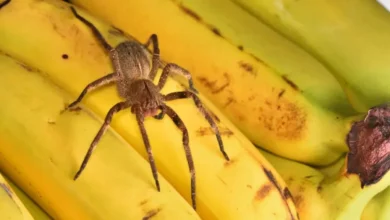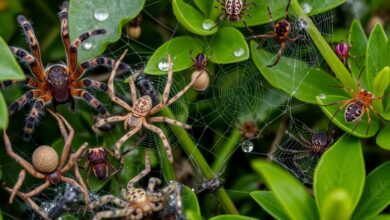Discover Texas Spiders: Your Guide to Local Arachnids
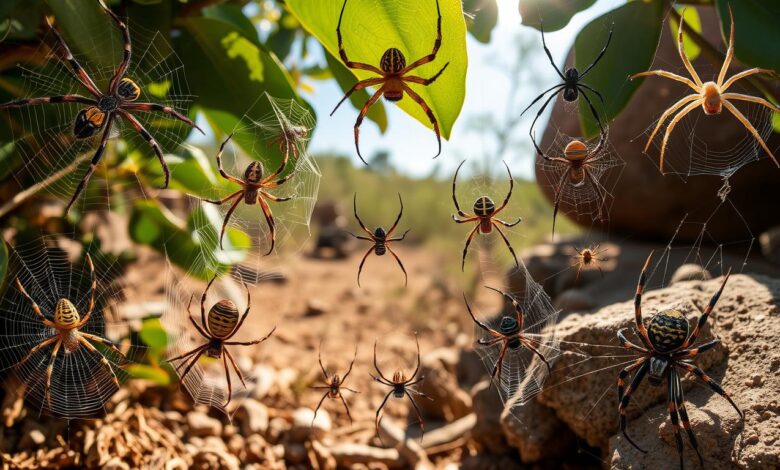
Texas is a paradise for spider lovers, with many different kinds of spiders. You’ll find everything from common house spiders to big, venomous ones. In this guide, we’ll explore the world of Texas spiders. We’ll look at their unique features, where they live, and how they help our environment.
House spiders, tarantulas, and wolf spiders are just a few examples of Texas’s spider variety. If you love nature, are curious, or just want to know more about spiders in your area, this guide is for you. It will help you understand and appreciate the amazing spiders of Texas.
Let’s dive into the world of Texas spiders and see their amazing abilities. We’ll learn how to spot different species and how they help our ecosystem. Get ready to be amazed by spider webs and the important role spiders play in our environment. Join us as we uncover the secrets of Texas’s fascinating spiders.
Introduction to Texas Spiders
Texas is home to a wide variety of spider species. Each plays a key role in the local ecosystem. You’ll find everything from house spiders to tarantulas and wolf spiders in the Lone Star State.
These spiders are not just interesting to watch. They also help control insect and pest populations. This keeps the ecosystem in balance.
Why Texas Spiders Matter
Spiders are vital in Texas’s food chain. They act as both predators and prey. By eating insects, they prevent overpopulation and maintain balance in their habitats.
Spiders are also a food source for many animals. This includes birds, reptiles, and small mammals. Understanding their importance helps us respect and coexist with them.
Texas Spider Diversity
There are over 1,000 different types of spiders in Texas. You’ll find everything from house spiders to tarantulas and wolf spiders. Each species has adapted to Texas’s unique habitats.
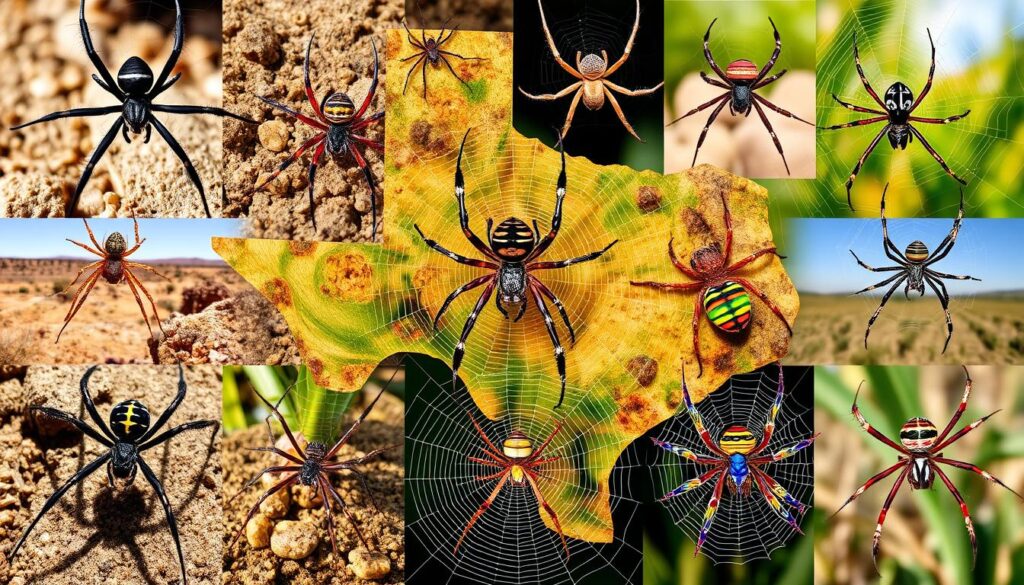
Exploring Texas spiders reveals a world of fascinating species. Each has its own unique traits and behaviors. Whether you love arachnids or just want to learn about local wildlife, discovering Texas spiders is rewarding and educational.
Common House Spiders in Texas
Not all spiders in Texas are scary. Many common house spiders are harmless to humans. Knowing about these spiders helps you live in peace with them.
Identifying Harmless Household Arachnids
In Texas, you’ll often see cellar spiders, daddy longlegs, and common house spiders. They might look scary, but they usually stay away from people. They’re not aggressive.
- Cellar Spiders: Known as “daddy longlegs spiders,” they have long legs and a small body. You’ll find them in dark, damp places like basements.
- Daddy Longlegs: They look scary, but they’re not true spiders. They belong to a different group and are harmless.
- Common House Spiders: You’ll see them in corners, making funnel-shaped webs. They have a round belly and short legs, and can be brown or gray.
Knowing about these spiders can make you less scared. It lets you live in peace with them. By learning about identifying spiders in texas homes, you can see their value in our world.
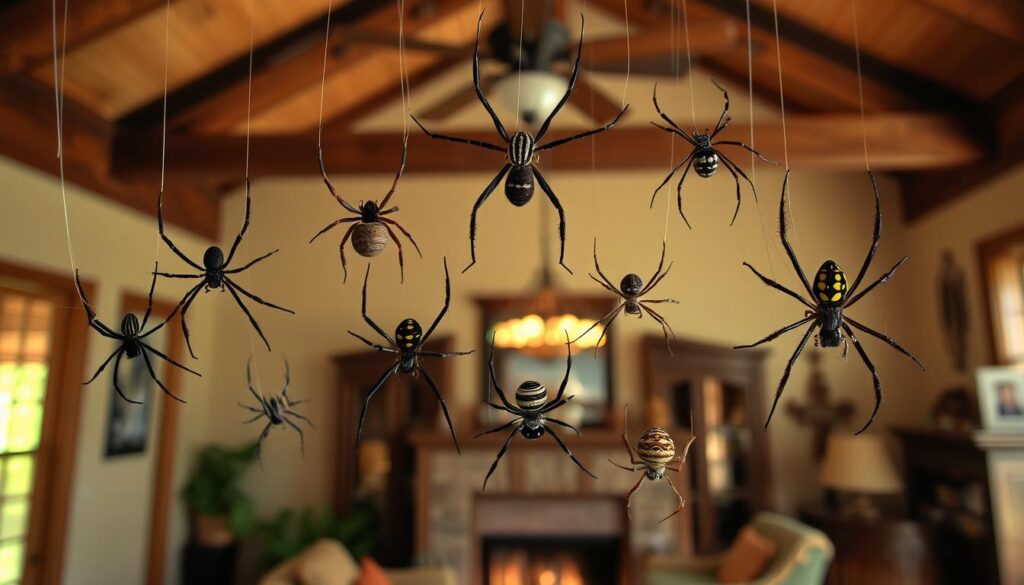
Venomous Spiders of Texas
Texas has many spiders, some of which can be dangerous to humans. It’s important to know which ones to watch out for. This knowledge helps keep us safe, especially in places where these spiders are common.
The brown recluse and black widow are two venomous spiders found in Texas. They can give painful bites that might need medical attention. Knowing how to spot them and how to stay safe is key.
- Brown Recluse Spider: This spider has a violin mark on its back. It’s small and brown, likes dark places. Its venom can harm tissue and, rarely, cause serious problems.
- Black Widow Spider: It has a shiny black body and a red hourglass mark. Its bite can be very dangerous. It might cause muscle pain, nausea, and breathing issues.
Even though some spider bites in Texas can be serious, not all are. Many spiders, like daddy longlegs and crab spiders, are safe for humans. They help keep pests away.
Learning about these spiders helps us stay safe in Texas. It also shows we respect their role in our ecosystem.
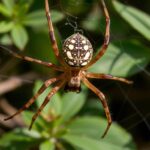 Hobo Spiders: Facts and Tips for Your Home
Hobo Spiders: Facts and Tips for Your Home
Brown Recluse Spider in Texas
The brown recluse spider is infamous in Texas. It has a violin-shaped mark on its back and is uniformly brown. Knowing how to spot it is key to avoiding bites and getting help if bitten.
Recognizing This Dangerous Spider
The brown recluse is small, about the size of a quarter. Its dark violin mark on the back is its most notable feature. It has long, slender legs and a brown color, making it hard to tell from other spiders. But, it has six eyes, unlike most household spiders.
Bite Symptoms and First Aid
- Brown recluse bites can be serious, causing tissue damage and other health issues.
- Symptoms include redness, swelling, pain, and sometimes a dead tissue area.
- Seek medical help right away if bitten. Quick treatment can prevent severe reactions.
- First aid includes cleaning the wound, using a cold compress, and avoiding tight devices.
Being careful and aware is crucial with the brown recluse spider in Texas. Knowing its look and the dangers of its bite helps keep you and your family safe.
Black Widow Spider in Texas
The black widow spider is found all over Texas. They have shiny black bodies and a red hourglass on their belly. Their bites can be serious and need quick medical help.
To spot a black widow spider in Texas, look for these signs:
- Glossy black body
- Red hourglass shape on the underside of the abdomen
- Relatively small size, typically less than 1.5 inches in length
Black widows like dark, quiet spots like under logs or in garages. If you see one, don’t touch it. Call a pest control expert to safely get rid of it.
If bitten by a black widow, get medical help right away. You might feel a lot of pain, muscle cramps, nausea, and trouble breathing. Antivenom can help and make you feel better.
Knowing what black widow spiders look like and where they live helps you stay safe. This way, you can avoid them and know how to act if you see one in Texas.
spiders of texas
Texas is home to many texas spider species. Each has its own look and way of living. From common house spiders to big tarantulas and wolf spiders, Texas is full of arachnids. Knowing about the types of spiders in texas helps us appreciate and live with them.
The cellar spider, or daddy longlegs spider, is often seen in homes. They look spindly but are good at keeping pests away. The orb weaver spider is also common, known for its beautiful spiral webs.
| Texas Spider Species | Characteristics | Habitat |
|---|---|---|
| Cellar Spider | Slender body, long legs | Basements, cellars, shady areas |
| Orb Weaver | Intricate spiral-shaped webs | Gardens, trees, shrubs |
| Tarantula | Large, hairy bodies, intimidating appearance | Arid and semi-arid regions |
| Wolf Spider | Fast runners, excellent hunters | Woodlands, fields, urban areas |
Texas also has tarantulas, known for their big, hairy bodies. They look scary but are mostly harmless. Wolf spiders are another interesting type, fast and good at catching prey.
Learning about types of spiders in texas helps us respect their role in our ecosystem. Whether it’s a simple house spider or a grand tarantula, each texas spider species adds to Texas’s rich life.
Wolf Spiders: Formidable Texas Hunters
Texas is a diverse place with over 900 spider species. Wolf spiders are among the most interesting, controlling insect numbers across the state. They are known for their hunting skills and unique behaviors, fascinating both nature and wildlife lovers.
Characteristics and Behaviors
Wolf spiders in Texas stand out with their large size and hairy bodies. Some can grow up to 1.5 inches long. They use their sharp eyesight and quick movements to catch prey.
One cool thing about wolf spiders is how they carry their egg sacs. This protects their young until they can take care of themselves.
Female wolf spiders are bigger and more aggressive than males. They fiercely protect their babies. This shows how important they are in keeping Texas’s ecosystems balanced.
Knowing about wolf spiders helps with pest control and conservation in Texas. They are key in controlling insect numbers, adding to the state’s rich spider diversity.
Texas Tarantula Species
Texas is home to many tarantulas, the biggest spiders in the state. Despite looking scary, tarantulas are usually calm and not aggressive. They have hairy bodies and move slowly, making them fascinating to watch.
 Discover Why Spiders Cute: Your New Fuzzy Friends
Discover Why Spiders Cute: Your New Fuzzy Friends
Learning about tarantulas in texas helps clear up myths. It also shows how amazing these types of tarantulas in texas are.
The Gentle Giants of the Arachnid World
Texas tarantulas come in different colors like brown, black, and even orange and pink. They are known for being gentle and using their size to scare off predators. Instead of attacking, they usually run away or stand their ground when threatened.
What’s interesting about texas tarantula species is how they hunt and burrow. They wait in their burrows or under rocks to catch their prey. Their strong fangs and venom help them catch insects, small rodents, and other spiders.
Even though they look scary, tarantulas in texas are not dangerous to people. Their venom isn’t strong enough to hurt seriously. But, it’s wise to be careful and show respect when you see them. They might bite if they feel scared.
Fascinating Texas Spider Facts
Texas spiders have many interesting facts and quirks. For example, some orb-weaver spiders can eat and remake their webs every day. Also, the venom of some Texas spiders might help in medicine. Learning about these spiders can make us appreciate their diversity and unique behaviors.
One cool interesting fact about Texas spiders is the discovery of spider-like features on Mars. These formations, called araneiform terrain, are over half a mile long. They were made by carbon dioxide gas, not by spiders on Earth. Scientists have tested this in labs, showing how Mars is different.
- Scientists found these Martian spider shapes in 2003 with orbiter images.
- They think these Martian spiders were made by carbon dioxide ice, not Earth spiders.
- Tests in a cold chamber at JPL showed how these Martian features are made.
On Earth, Texas spiders also have amazing abilities. For example, many species, like the orb-weaver, remake their webs every day. This is a great example of their engineering skills. Also, some Texas spider venoms might help in medicine, with research still going on.
Exploring Texas spiders can make us see them in a new light. From the Martian araneiform terrain to their web-building on Earth, there’s always more to learn. These spiders are truly fascinating.
| Statistic | Value |
|---|---|
| Araneiform terrain size | More than a half-mile (1 kilometer) |
| Number of “legs” in Martian spiders | Hundreds |
| Martian surface temperature | Minus 301 degrees Fahrenheit (minus 185 degrees Celsius) |
| Duration of carbon dioxide gas plume | Up to 10 minutes |
Spider Web Architecture Marvels
Spiders in Texas are amazing at building webs. The orb-weaver spiders are especially known for their detailed webs. They make spiral patterns and shapes that decorate gardens and landscapes in Texas.
Seeing how orb weaver spiders in texas build their webs is truly awe-inspiring. Their webs show incredible complexity and symmetry. This shows how their web-building skills have evolved over time.
Intricate Orb-Weaver Designs
Orb-weaver spiders are masters at making spiral webs. They place threads with great care, creating beautiful webs. These webs are strong and catch prey, despite the weather.
| Spider Species | Web Design Characteristics |
|---|---|
| Golden Orb-Weaver | Constructs large, circular webs with a distinct golden hue, often found in wooded areas. |
| Argiope Orb-Weaver | Known for their elaborate, zig-zag patterns and a distinctive “X” shape in the center of the web. |
| Furrow Orb-Weaver | Builds intricate webs with a distinctive spiral pattern, commonly seen in gardens and urban landscapes. |
The spider webs in texas made by these spiders are stunning. They show the cleverness and adaptability of nature. By looking at these webs, we learn to appreciate the variety of spiders in Texas.
Beneficial Spiders in the Garden
If you garden or own a home in Texas, you might be surprised. Some spiders are actually good for your outdoor spaces. These spiders that eat pests in texas help by eating insects that harm your plants.
By welcoming these helpful spiders in texas gardens, you get natural pest control. They help keep your plants safe and your garden healthy. These spiders are key to a balanced ecosystem.
Some common beneficial spider species in Texas gardens include:
- Crab Spiders – These spiders ambush their prey, making them effective hunters of insects that can harm your plants.
- Jumping Spiders – Known for their exceptional eyesight, jumping spiders are agile predators that feed on a range of garden pests.
- Orb-Weaver Spiders – The intricate web designs of these spiders can trap and ensnare various flying insects, keeping your garden free from unwanted visitors.
- Lynx Spiders – These hunters are adept at catching caterpillars, aphids, and other sap-sucking insects that can damage your plants.
Understanding the role of these spiders that eat pests in texas is key. You can encourage them to help control pests naturally. This way, you can keep your garden healthy without harsh chemicals.
| Spider Species | Prey | Benefits to the Garden |
|---|---|---|
| Crab Spiders | Insects, such as flies, bees, and butterflies | Effective hunters of garden pests |
| Jumping Spiders | A variety of insects and small arthropods | Agile predators that control diverse garden pests |
| Orb-Weaver Spiders | Flying insects trapped in their intricate webs | Natural pest control through web-based trapping |
| Lynx Spiders | Caterpillars, aphids, and other sap-sucking insects | Effective at catching and consuming common garden pests |
Ethical Spider Removal Tips
Some spiders in Texas might worry us, but we should remove them ethically. It’s better to move them to a safer place than to harm them. This way, we keep the ecosystem balanced and respect the spider’s life.
Using spider traps, like glue boards, is a kind way to catch them. Place these traps where you see spiders often. You can also try using peppermint or chestnuts to keep them away without harming them.
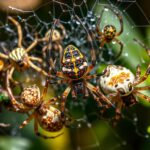 Poisonous Spiders: What You Need to Know
Poisonous Spiders: What You Need to Know
If you meet a venomous spider, like a black widow or brown recluse, be careful. It’s wise to get help from pest control experts. They can safely remove these spiders without risking your safety or theirs.

